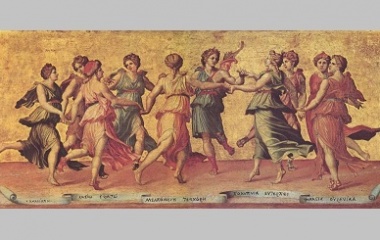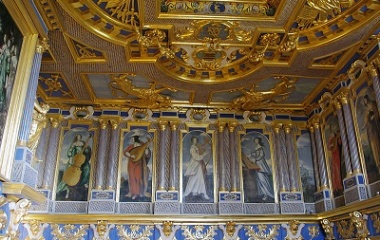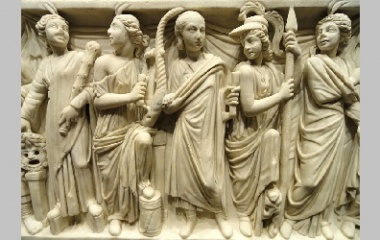- Pronunciation: m-OO-s-eh
- Origin: Greek
- Role: Goddesses of science, arts and literature
- Symbols: Scroll, Tablet, Shepherd’s Crook
- Number: 9
- Parents: Zeus, Mnemosyne
- Other Name: The Muses
Who Is Muse?
Muse is another name for the Muses, the Greek goddesses who inspired science, the arts, and literature. There were nine Muses, all daughters of Zeus and Mnemosyne, the personification of memory. They are sometimes classified as water nymphs. Some mythologists believe them to have been primordial goddesses and daughters of Uranus and Gaea. They are considered to be the inspiration behind various lyrical poems, including the Homeric epics.
Purpose
The Muses represented personifications of art and knowledge. Some arts associated with the goddesses include science, mathematics, drama, music, and geography. It is believed that the Muses could inspire artists or speak through their words.
Origins
Though there are conflicting variations of their myths, it is widely accepted that the Muses were the daughters of Zeus and Mnemosyne. Zeus disguised himself as a shepherd and seduced Mnemosyne. They laid together for nine consecutive nights. Nine months later, the Muses were born at the base of Mount Olympus. It is believed that the goddesses lived on Mt. Olympus and entertained Zeus with their artistic talents. Apollo also had direct contact with the Muses and led them in music. He also fathered many children with several of the Muses, including Orpheus, son of Calliope. Other variations say that they lived on Mt. Helicon or Mt. Parnassus.
Legends and Stories
Most myths involving the Muses are short but sweet as they usually have a supporting role. In one myth, the Muses judged a competition between Marsyas and Apollo. In another, they helped to gather the pieces of Orpheus’ deceased body and bury them. In yet another, Thamyris challenged the goddesses to a singing contest. Their talents made them the winner and they punished Thamyris by blinding him and leaving him unable to sing.
A more popular myth says that King Pierus of Macedon had nine daughters of his own. He decided to name them after the Muses and believed that his daughters’ talents rivaled those of the Muses. He challenged the goddesses in a battle of skills and talent against his daughters. But the king’s daughters were no match for the Muses and their talents. Once the competition was over, the king’s daughters were turned into chattering magpies for their insulting presumption.
The Muses Gifts, Appearances, and Symbols
There were nine Muses, all with their own unique talents and attributes. Here are descriptions of each Muse, including what they represented, some of their physical descriptions, and symbolic items.
Calliope
Calliope was the chief of the nine Muses and the patron of poetry. She was the mother or Orpheus. Her symbol was a writing tablet, which is included in almost all artistic representations of her. She was very mythically involved compared to her sisters. She is often called the goddess of marriage and the sad song god. She is known as the Beautiful Voice and typically lead the others in song.
Clio
Known as the Proclaimer, Clio was the patron of history. She invented heroic and historical poetry. She had one son named Hyacinthus, conceived with King Pierus. Hyacinthus was an attractive man but eventually killed by his lover, Apollo. His blood dripped onto the ground where a beautiful flower grew, which would be named after him. Clio is credited with introducing the Phoenician alphabet to Greece. Because of this, her symbol is a scroll, similar to Calliope.
Erato
Main descriptions of this goddess include passionate and lovely. While all the Muses were attractive, Erato had an appealing demeanor about her. She was the Muse of lyric poetry, specifically poems about love and eroticism. She was the Muse of mimicry as well and was associated with parrots and crows.
Euterpe
Euterpe was the most cheerful and joyful Muse. She was the Muse of lyric poetry and music. She was also responsible for pleasure and joy. While some mythologists credit Athena with the invention of the flute, many say it was actually Euterpe. Her symbol is the double flute.
Polyhymnia
Polyhymnia was the Muse of the Sacred Hymn and Eloquence. She was quite possibly the most beautiful Muse and had a somber personality. In artistic representations, she is usually shown with a serious facial expression and is either meditating or sitting with a finger to her mouth in thought. She is usually dressed in plain yet elegant long robes.
Melpomene
Melpomene was known as the Songstress and was the Muse of tragedy. Though associated with unwanted events, she was quite beautiful. She is normally shown wearing boots known as cothurnus and either wearing or carrying a tragic mask. Her symbols include a knife or a club.
Terpsichore
Known simply as Whirling, Terpsichore was the Muse of dancing and choral singing. In artistic representations, she is almost always shown with a lyre in her hands and in the middle of a joyful dance. She did have at least one child but many of the stories contradict each other. In some, she is the mother of the Sirens with Achelous, the river god. Others say she is the mother of Linus with Apollo, though some texts say either Calliope or Urania have the title of Linus’ mother.
Thalia
Thalia ruled over pastoral poetry and comedy. In artistic representations, she is shown holding a comic mask. She is also usually holding a shepherd’s crook, a symbolic tribute to her love of nature. She spent her free time exploring the meadows and forests.
Urania
Urania was the Muse of astrology and astronomy. Some variations of the Muses’ myths depict her as the mother of Linus. Linus’ father was Amphimarus, a son of Poseidon. He was such an incredible singer that Apollo became incredibly jealous. His jealousy eventually led him to murder Linus. Urania is usually shown with a globe in one hand and a pair of compasses in the opposite hand. In pictures, she is shown with her feet resting on a turtle, which is a symbol of retreat and silence.










